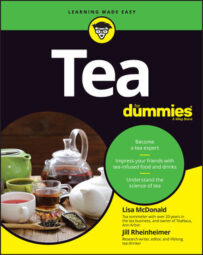With our tips, you can brew any tea and get terrific results. Of course, you’ll want to experiment a bit for your personal preference, but that’s part of the fun!
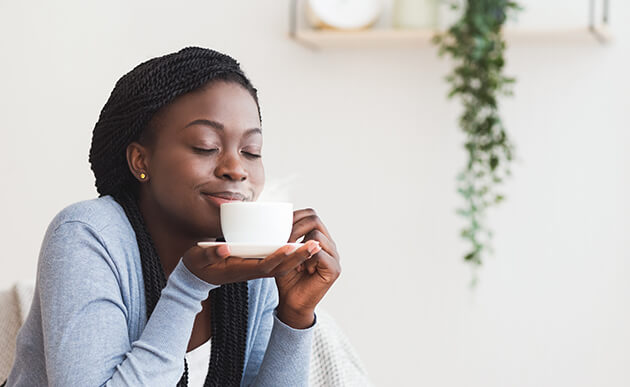 ©Prostock-studio / Adobe Stock
©Prostock-studio / Adobe StockBasic equipment
This is all you need to brew tea:- Something to heat water
- A cup or mug
- A brew basket or strainer of some sort
Ways to heat water
Some pretty fancy water kettles are out there these days. Even we are drawn toward the ones with all the buttons, temperature controls, automations, and stellar designs. At our tea shop, TeaHaus, we have three water dispensers that offer a constant supply of filtered water, each set at a specific temperature. However, at home, I have a simple glass electric kettle.If you’d rather not have an electric kettle that takes up space on your countertop, you can easily heat water in a pan on your stove (keep reading to learn how to visually gauge water temperature), although a whistling kettle is nice.
A whistling kettle lets you know when your water is boiling and reminds you to turn the stove off, a good safety feature. Any style of whistling kettle will do but stay away from cheap aluminum or thin stainless steel. It is worth the few extra dollars to get a sturdier kettle.
We recommend that you never use a microwave oven to heat your water. The water heats unevenly, you can’t control the temperature with any accuracy, and you can easily burn yourself with superheated water.
Cup or mug
Much debate is ongoing about whether a cup should be glass, or porcelain, or clay, or some other material. Although the array of cup choices adds to the drinking experience, in this article, we’re keeping it simple, so go with a cup or mug of your choosing. I prefer white porcelain or glass because I like to see the color of my tea, but everyone has that favorite mug or cup.Strainer
If we are making a cup of tea for ourselves, we like to use a tea brewing basket that we can set directly into a mug or cup. However, a small kitchen strainer will also get the job done.We don’t recommend the classic tea balls for most loose-leaf teas because the leaves need room to expand. For example, the bottom photo in the figure below shows how oolong tea leaves unfurl into intact leaves and leaf sets that would be too tightly packed into a tea ball.
However, these balls are often adequate for small-leaf teas or cut-tear-curl (CTC) teas, like a classic English breakfast. In the top photo below, you can also see that the English breakfast tea leaves expanded only a little bit during brewing.
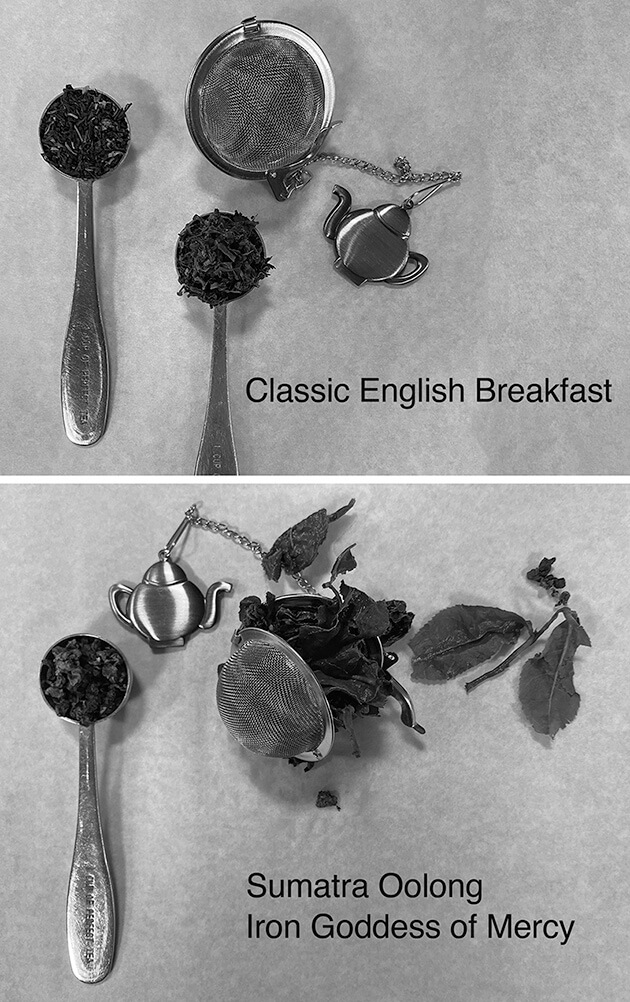 ©Lisa McDonald
©Lisa McDonaldEnglish breakfast tea leaves don't expand significantly during brewing (top), unlike the intact leaves and leaf sets of an oolong (bottom).
Making a cup of hot tea
When you have your basic brewing equipment, all you need are tea leaves and water. Here’s an easy guide to making a terrific cup of tea:Measuring your tea leaves
Most teabags are perfectly portioned for an 8- to 12-ounce cuppa, but it gets a bit tricky with loose-leaf tea. Many directions say you should use a teaspoon or a heaping teaspoon of tea leaves, but this isn’t always the best form of measurement for the perfect cup.The problem is that tea leaves vary from tea to tea, sometimes dramatically. Therefore, measuring tea by weight is more accurate than measuring tea using a teaspoon. You generally need about three grams of tea for an 8- to 12-ounce cup. So, when we train new employees to brew tea at TeaHaus, we have them use a gram scale for the first few weeks.
After they get a feel for what 3 grams of various teas look like, they can start to use an eyeball estimate, along with a teaspoon, when brewing tea for customers. If a customer likes a stronger or weaker tea, we don’t adjust the brew time or the recommended temperature. Instead, we adjust the amount of tea used.
If you don’t have a gram scale, start by using a teaspoon, but remember that you’ll need to adjust for the tea. The photo below shows an example of how 3 grams of tea can look drastically different.
Three grams of CTC tea (left side of photo) are easily measured by a teaspoon. However, some whole-leaf teas, especially those that are very fluffy, like the tea on the right side of the photo, require more tea by volume. For these teas, if your directions say to use a “heaping teaspoon,” you may find that the leaves are so difficult to measure with a teaspoon (they are large, unwieldy, and don’t stay nicely on the spoon!) that realistically you may need a mega-heaping teaspoon or two heaping teaspoons.
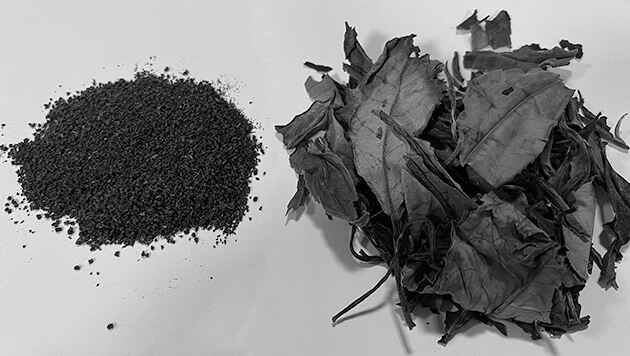 ©Lisa McDonald
©Lisa McDonaldComparison of 3 grams of a CTC Irish breakfast tea (left) and 3 grams of South India havukal, a whole-leaf white tea.
Keep in mind that no exact science dictates how much tea to use, and personal preference should help you decide how strong you like your tea, and therefore, how much tea to use.
Heating your water
Whether you have a stove top kettle or a simple electric one, we have a few recommendations. At home, we really like an electric kettle. We especially like the glass ones because we can see the bubbles form, which indicates the approximate temperature of the water.You can easily teach yourself how to visually gauge the water temperature (this also works well if you’re heating your water in a pan on the stove):
- Shrimp eyes. When tiny bubbles (shrimp eyes) start to form on the bottom of the kettle, the water is approximately 155 to 160 degrees F.
- Crab eyes. When the water starts to produce steam and the bubbles are bigger (crab eyes) but are still on the bottom, the temperature is around 175 degrees F.
- Fish eyes. When the bubbles (fish eyes) begin to release from the bottom, the temperature is around 180 to 185 degrees F.
- Pearl strands. When the bubbles are more like a strand of pearls than eyes, the water is between 190 and 205 degrees F.
- Boil. Soon after, you have a rolling bubble, which is 212 degrees F.
If your kettle isn’t transparent and you can’t see the bubbles, you can listen for the sound. You’ll know when you’re at the pearl stage because you will hear the low rumble of the pot as the bubbles begin to release. This is, of course, all made easier with a thermometer or a temperature-control kettle.
Brewing hot tea
At TeaHaus, we give our customers a little guide to brewing. The front of the postcard illustrates the brewing steps (see the figures below), and the back provides a simple guide for brewing time and temperature.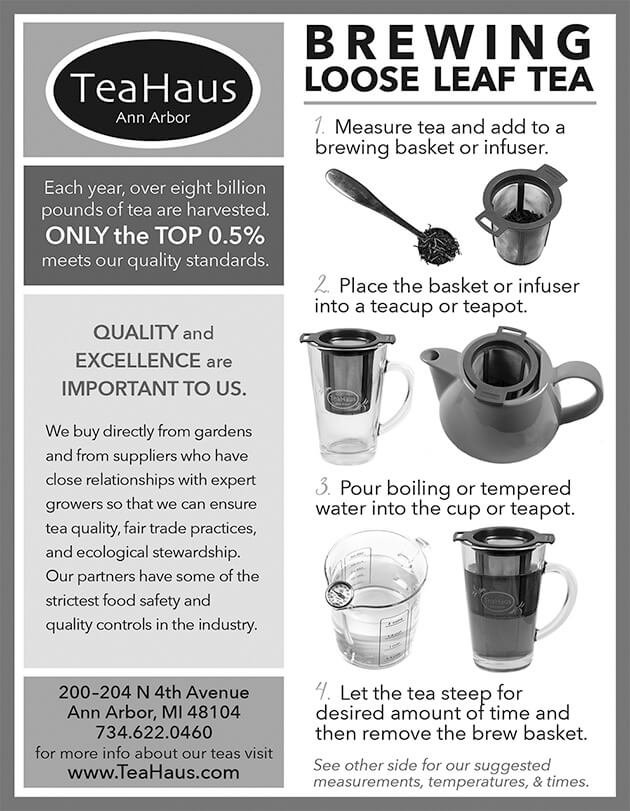 ©TeaHaus
©TeaHausTea brewing guide
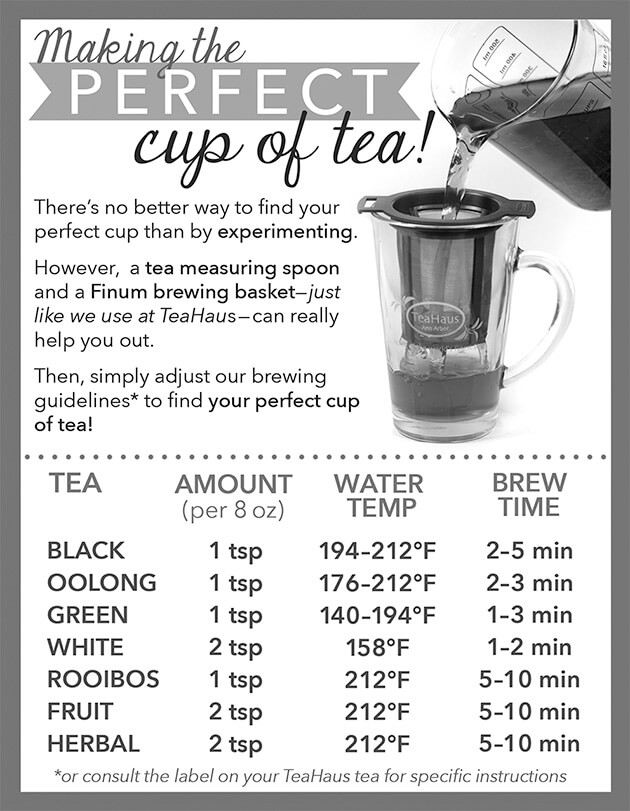 ©TeaHaus
©TeaHausBrewing guide by tea type
You’ll see that most teas have a range of water temperatures, but less-oxidized green tea is always brewed at lower temperatures than fully oxidized black tea. White tea, the most delicate and minimally processed of leaves, must always be brewed at relatively low temperatures or else you damage the leaves, and your tea won’t taste very good.
Note, too, that if you brew tea for too long a time, it will become bitter. Herbal teas (this includes rooibos and fruit teas), on the other hand, can never be over-brewed.
Keep in mind that these recommendations are just starting points; you should always adjust the parameters to best fit your own preference.
Steps to a perfect cup
To brew one cup of tea at a time using a cup-sized brewing basket, follow these steps:- Place the basket into your cup.
- Add about 3 grams of tea into the basket. (See the “Measuring your tea leaves” section above.)
- Pour hot water over the leaves and set a timer. At TeaHaus, we put our recommended brewing time and temperature on the package for each tea, but when in doubt, brewing for 2–5 minutes is going to be okay for most teas, depending on the tea and your tolerance for bitterness.
- When the timer goes off, remove the basket, and your tea is ready to drink.
- Shake out the leaves into your compost bin or trash and rinse out the remaining leaves — unless it’s a tea that you want to rebrew later in the day. In that case, you can just let the leaves stay in the basket (no need to refrigerate).
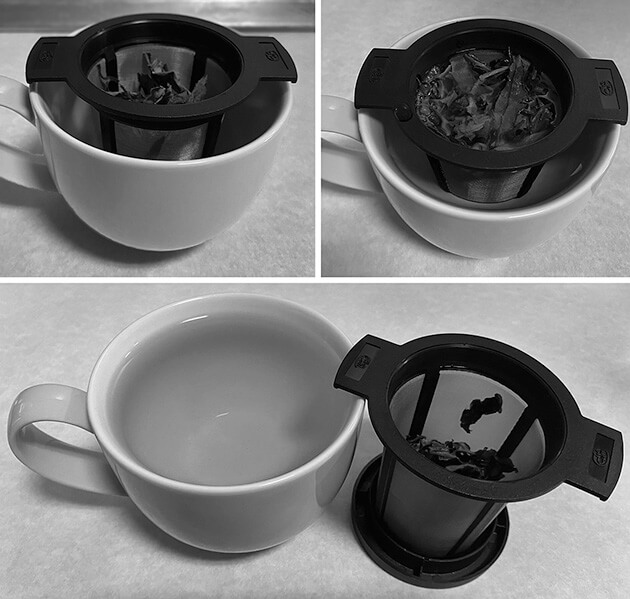 ©Lisa McDonald
©Lisa McDonaldSteps for brewing a cup of tea with a basket filter
Step 5 is where teabags are easier to use — even we will admit that. However, you can make your own teabags ahead of time. Just purchase paper filters or teabags for loose tea and spend a few minutes filling enough for the week, for example. Keep in mind, though, that the bag, much like the tea ball, will constrict some unfurling of the leaves, so larger-leaf teas are still best when brewed using a strainer or basket.
Here is an alternate way to make either a cup or a pot of tea. This method allows the leaves to really unfurl and move around freely, which gives you a better cup of tea (see the photo below). Follow these steps:
- Measure your tea leaves into any vessel that can withstand heat. (We recommend a glass vessel, such as a glass measuring cup.)
- Pour your hot water over the leaves and set your timer.
- When the timer goes off, strain the leaves through a brewing basket (or even a small kitchen strainer) into your teacup or tempered teapot.
- If you plan to rebrew the tea, shake the leaves back into the brewing vessel; otherwise, shake them into your compost bin or trash.
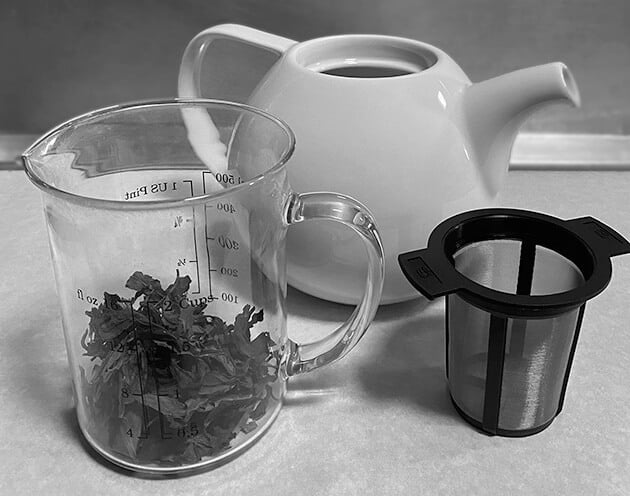 ©Lisa McDonald
©Lisa McDonaldBrewing a pot of tea using a basket filter
People ask all the time if they can rebrew their leaves. With a brewing basket, it is quite simple. Just place the basket back in your cup and pour more water over it. If you’ve brewed your leaves loose in another vessel, simply add water again.
There are some teas that rebrew well and others that don’t. We always recommend that people just try it. There is no real answer. Larger leaves often brew better the second time around since they unfurl more during the second brew, but, again, this is up to personal preference.

